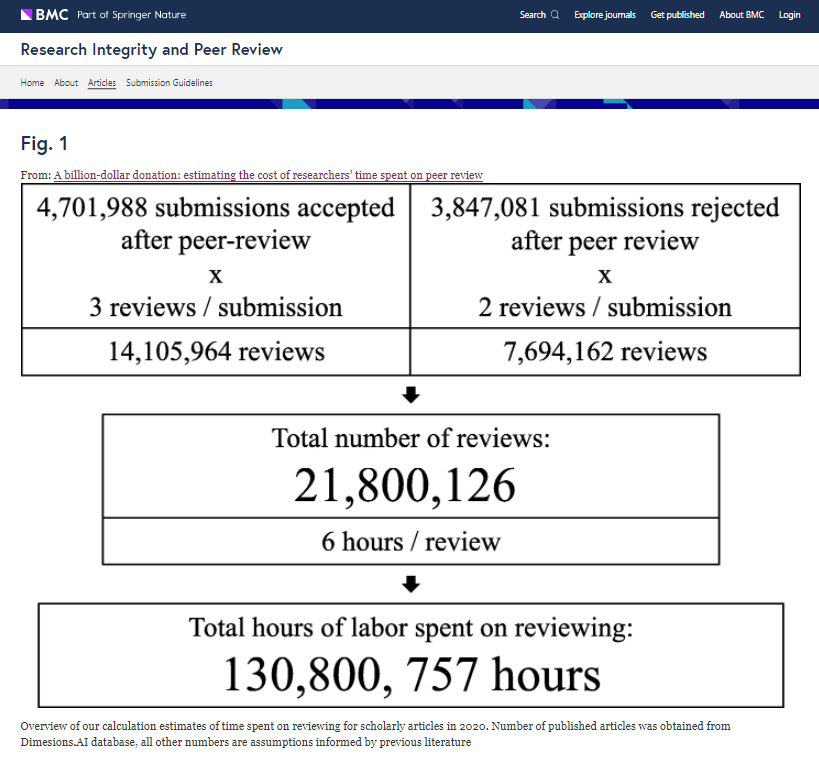Balazs Aczel [1], Barnabas Szaszi [1], Alex O. Holcombe [2]
[1] Institute of Psychology, ELTE, Eotvos Lorand University, Izabella u. 46, Budapest, 1064, Hungary
[2] School of Psychology, University of Sydney, Sydney, Australia
Res Integr Peer Rev 6, 14 (2021). https://doi.org/10.1186/s41073-021-00118-2
Abstract
Background. The amount and value of researchers’ peer review work is critical for academia and journal publishing. However, this labor is under-recognized, its magnitude is unknown, and alternative ways of organizing peer review labor are rarely considered.
Methods. Using publicly available data, we provide an estimate of researchers’ time and the salary-based contribution to the journal peer review system.
Results. We found that the total time reviewers globally worked on peer reviews was over 100 million hours in 2020, equivalent to over 15 thousand years. The estimated monetary value of the time US-based reviewers spent on reviews was over 1.5 billion USD in 2020. For China-based reviewers, the estimate is over 600 million USD, and for UK-based, close to 400 million USD.

Conclusions. By design, our results are very likely to be under-estimates as they reflect only a portion of the total number of journals worldwide. The numbers highlight the enormous amount of work and time that researchers provide to the publication system, and the importance of considering alternative ways of structuring, and paying for, peer review. We foster this process by discussing some alternative models that aim to boost the benefits of peer review, thus improving its cost-benefit ratio.
Cite this article
Aczel, B., Szaszi, B. & Holcombe, A.O. A billion-dollar donation: estimating the cost of researchers’ time spent on peer review. Res Integr Peer Rev 6, 14 (2021). https://doi.org/10.1186/s41073-021-00118-2
New paper: “A billion-dollar donation: estimating the cost of researchers’ time spent on peer review” – by @BalazsAczel, @szaszibarnabas, & I. https://t.co/E6yvsuNvoe ??
— Alex Holcombe (@ceptional) November 15, 2021
Discover the tweets citing this article
Rights and permissions
Open Access This article is licensed under a Creative Commons Attribution 4.0 International License, which permits use, sharing, adaptation, distribution and reproduction in any medium or format, as long as you give appropriate credit to the original author(s) and the source, provide a link to the Creative Commons licence, and indicate if changes were made. The images or other third party material in this article are included in the article’s Creative Commons licence, unless indicated otherwise in a credit line to the material. If material is not included in the article’s Creative Commons licence and your intended use is not permitted by statutory regulation or exceeds the permitted use, you will need to obtain permission directly from the copyright holder. To view a copy of this licence, visit http://creativecommons.org/licenses/by/4.0/. The Creative Commons Public Domain Dedication waiver (http://creativecommons.org/publicdomain/zero/1.0/) applies to the data made available in this article, unless otherwise stated in a credit line to the data.
